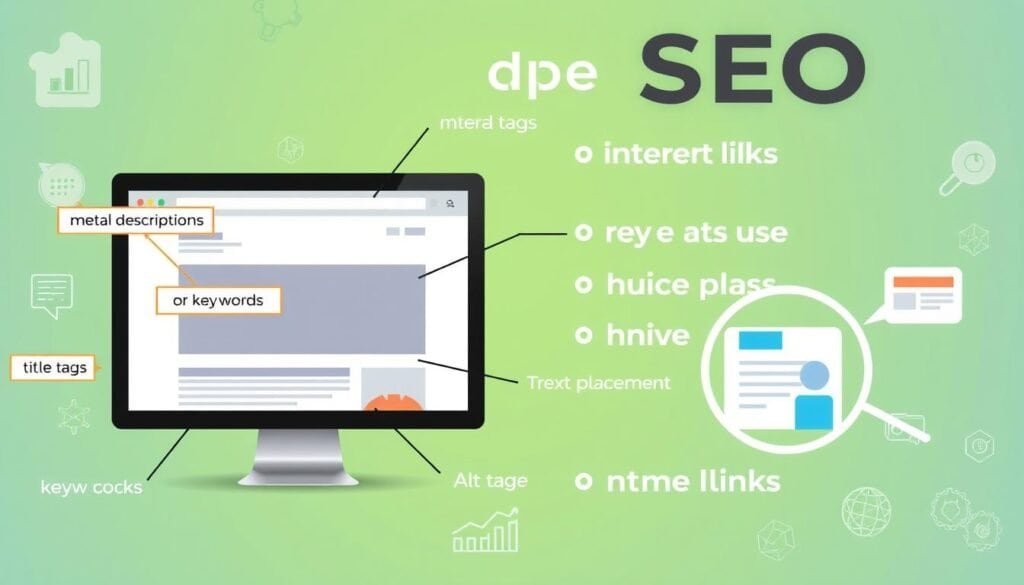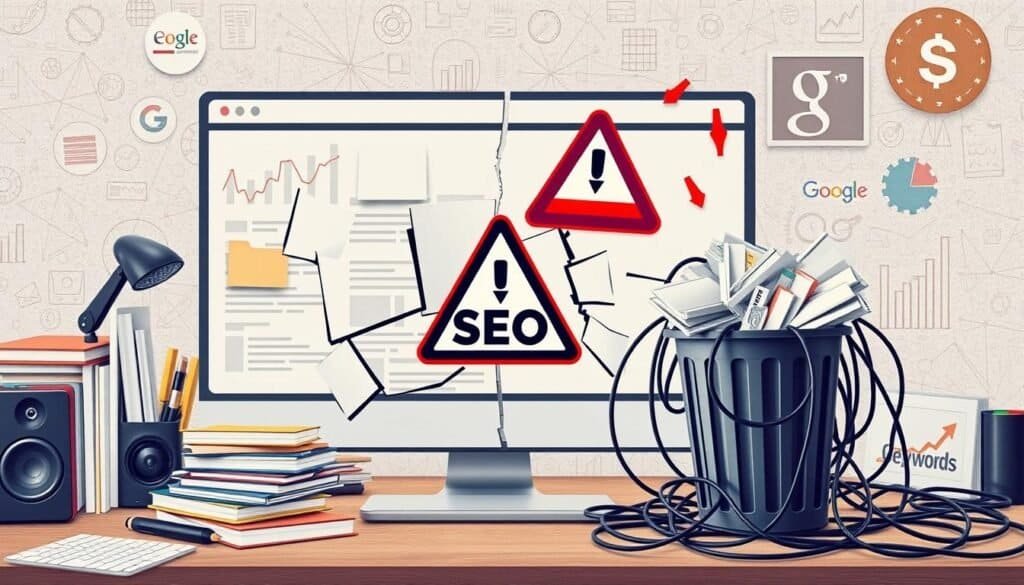As Google continues to roll out major algorithm updates, with four significant updates in 2023, it’s essential to stay ahead of the game by avoiding common SEO mistakes. These mistakes can significantly impact your online visibility, making it crucial to understand how to prevent SEO pitfalls and avoid SEO errors to avoid. So, what are the most common SEO mistakes that can hurt your website’s ranking, and how can you avoid them to prevent SEO pitfalls?
Avoiding common SEO mistakes is vital to improving your website’s online visibility and driving more traffic to your site. By understanding how to avoid SEO mistakes and prevent SEO errors to avoid, you can increase your chances of success in the competitive online market. With user intent being mentioned 333 times in Google’s Quality Raters Guidelines, it’s clear that understanding your audience is key to avoiding common SEO mistakes and preventing SEO pitfalls.
Key Takeaways
- Avoiding common SEO mistakes is crucial for online visibility and success
- Understanding user intent is key to avoiding common SEO mistakes
- Preventing SEO pitfalls can improve your website’s ranking and drive more traffic
- Avoiding SEO errors to avoid can increase your chances of success in the online market
- Common SEO mistakes can be avoided by following SEO best practices and staying up-to-date with the latest trends
- Setting SEO goals and using tools like internal linking can help prevent common SEO mistakes
- Staying ahead of the game requires continuous learning and adaptation to avoid common SEO mistakes
Ignoring Keyword Research Best Practices
Keyword research is a crucial aspect of search engine optimization (SEO) that helps businesses understand their target audience and create content that resonates with them. By conducting thorough keyword research, companies can identify the most relevant keywords and phrases for their content, increasing their chances of ranking higher in search engine results. This is where SEO best practices come into play, as they provide a framework for effective keyword research and implementation.
Understanding keyword intent is vital in creating content that meets the needs of the target audience. Keyword intent refers to the reason behind a user’s search query, and it can be informational, navigational, or transactional. By understanding keyword intent, businesses can create content that addresses the specific needs of their audience, increasing engagement and conversion rates. Common search engine optimization mistakes, such as keyword stuffing, can be avoided by using tools for effective keyword research, such as Semrush or Ahrefs.
Understanding Keyword Intent
Keyword intent can be categorized into three main types: informational, navigational, and transactional. Informational intent is when a user is searching for information on a particular topic, while navigational intent is when a user is searching for a specific website or webpage. Transactional intent is when a user is searching for a product or service to purchase. By understanding these different types of keyword intent, businesses can create content that meets the specific needs of their audience.

Tools for Effective Keyword Research
There are several tools available for effective keyword research, including Semrush, Ahrefs, and Google Keyword Planner. These tools provide insights into keyword volume, competition, and intent, helping businesses to identify the most relevant keywords and phrases for their content. By using these tools, companies can avoid common search engine optimization mistakes, such as keyword stuffing, and create content that resonates with their target audience.
Neglecting On-Page SEO Elements
On-page SEO is a crucial aspect of search engine optimization that involves optimizing individual web pages to rank higher in search engines. Neglecting on-page SEO elements can lead to poor search engine rankings and reduced website traffic. Best practices for SEO include optimizing meta titles, header tags, and internal linking to improve website visibility and drive more traffic to the site.
Some key on-page SEO elements to focus on include meta titles and descriptions, which help search engines understand the content of a webpage. Optimising header tags for SEO is also essential, as it helps to structure the content and highlight important keywords. Internal linking is another important aspect of on-page SEO, as it helps to guide users and search engines through the website and improve user experience.
Importance of Meta Titles and Descriptions
Meta titles and descriptions are essential on-page SEO elements that help search engines understand the content of a webpage. By optimizing these elements, businesses can improve their website’s visibility in search engine results pages (SERPs) and drive more traffic to their site. For example, a well-written meta title can increase click-through rates, while a descriptive meta description can improve search engine rankings.
Optimising Header Tags for SEO
Header tags, such as H1, H2, and H3, are used to structure the content of a webpage and highlight important keywords. Optimising header tags for SEO is essential, as it helps search engines understand the content and context of a webpage. By using header tags effectively, businesses can improve their website’s search engine rankings and drive more traffic to their site.

The Role of Internal Linking
Internal linking is an important aspect of on-page SEO that helps to guide users and search engines through the website. By linking to relevant and useful content, businesses can improve user experience and increase engagement. Internal linking also helps search engines to understand the structure and context of a website, which can improve search engine rankings and drive more traffic to the site.
Overlooking Mobile Optimisation
With over 50% of all web traffic coming from mobile devices, mobile optimisation is crucial for websites. A well-optimised mobile site can see up to a 20% increase in organic traffic compared to non-optimised sites. Mobile friendliness is essential for providing a good user experience and improving website accessibility.
Some key considerations for mobile optimisation include:
- Responsive design to ensure compatibility with various devices
- Fast page loading speeds to prevent user abandonment
- Easy navigation and clear content to enhance user experience
By incorporating mobile optimisation into their SEO strategy tips, businesses can improve their online visibility and drive more traffic to their site. As Google has confirmed that page speed is a ranking factor, optimising for mobile can also improve search engine rankings.

Studies have shown that 80% of mobile users are more likely to convert if the site is mobile-friendly, highlighting the importance of mobile optimisation for businesses. By prioritising mobile friendliness and responsive design, companies can stay ahead of the competition and improve their overall SEO strategy.
Failing to Monitor Performance Metrics
Monitoring performance metrics is crucial for any business to understand its online presence and make data-driven decisions. By tracking key metrics such as website traffic, engagement, and conversion rates, businesses can identify areas of improvement and adjust their SEO strategies accordingly. This helps to improve their online visibility, drive more traffic to their site, and ultimately increase their revenue.
Effective SEO tracking involves analyzing data to identify trends and patterns. This can be done using tools like Google Analytics, which provides valuable insights into website performance and user behavior. By analyzing this data, businesses can identify areas where they need to improve and make adjustments to their SEO strategies. For instance, if a business notices a high bounce rate on a particular page, they can adjust their content and metadata to improve user engagement and reduce bounce rates.
Key Metrics to Track for SEO
- Website traffic and engagement metrics, such as page views and time on site
- Conversion rates, such as form submissions and sales
- Keyword rankings and search engine visibility
By monitoring these metrics and adjusting their SEO strategies based on data analysis, businesses can improve their SEO performance and achieve their online goals. Regularly reviewing and refining their SEO strategies helps businesses stay ahead of the competition and drive long-term growth.
Tools for Analysing SEO Performance
There are many tools available for analyzing SEO performance, including Google Analytics, SEMrush, and Ahrefs. These tools provide valuable insights into website performance, keyword rankings, and user behavior, helping businesses to identify areas for improvement and make data-driven decisions.
Content Quality and Consistency
While optimising your website’s technical aspects is crucial for improved SEO performance, the quality and consistency of your content play an equally vital role. Crafting original, engaging content that resonates with your target audience is key to building a strong online presence.
The Importance of Original Content
Providing unique, high-quality content not only helps your website rank higher in search engine results but also establishes your brand as an authoritative and trustworthy source. According to the third source, original content is crucial for improving website accessibility and ensuring your target audience receives genuine value. Avoid the pitfalls of duplicate or low-quality content, which can negatively impact your search engine visibility.
Maintaining a Regular Posting Schedule
Consistency is key when it comes to content marketing. Maintaining a regular posting schedule demonstrates to both search engines and your audience that your website is actively updated and full of fresh, relevant information. By consistently publishing new content, you can keep your audience engaged and improve your chances of appearing in search results.
Engaging Your Audience with Quality Content
The ultimate goal of your content strategy should be to create valuable, engaging content that resonates with your target audience. Whether it’s informative blog posts, visually appealing infographics, or captivating video content, focus on delivering content that provides real value to your readers. This not only improves user engagement but also signals to search engines that your website is a trusted and authoritative source.
By maintaining a strong focus on content quality and consistency, you can position your website for long-term SEO success. Remember, high-quality, original content is the foundation upon which effective search engine optimisation is built.
Source Links
- 15 Common SEO Mistakes You Need to Avoid in 2025 – https://www.99signals.com/common-seo-mistakes/
- How to avoid 10 common SEO interview mistakes and land your next job – https://searchengineland.com/common-seo-interview-mistakes-450464
- Ecommerce SEO Best Practices – https://agital.com/blog/ecommerce-seo-best-practices/
- Content Marketing Missteps: Common Mistakes and How to Fix Them – https://www.lastclick.com.au/blog/content-marketing-missteps-common-mistakes-and-how-to-fix-them
- SEO Keyword Research: 18 Of The Biggest Mistakes You Must Avoid – https://www.searchenginejournal.com/keyword-research/mistakes-to-avoid/
- On-Page SEO vs Technical SEO: A Comprehensive Guide to Mastering Search Engine Optimization – https://www.pageoptimizer.pro/blog/on-page-seo-vs-technical-seo-a-comprehensive-guide-to-mastering-search-engine-optimization
- Most Common SEO Mistakes To Avoid In 2025 – https://www.ezrankings.com/blog/common-seo-mistakes-avoid/
- SEO For Beginners: Common Mistakes And How To Avoid Them – MarketSmiths – https://www.marketsmiths.co/resources/seo-for-beginners-common-mistakes-and-how-to-avoid-them/
- 15 Bad SEO Practices You Should Avoid in 2025 [Solved] – https://www.omnius.so/blog/bad-seo-practices
- How to Measure SEO Performance & Results – https://backlinko.com/hub/seo/seo-results
- Top 5 Common SEO Mistakes Small Businesses Make and How to Avoid Them – https://onlinebizbuilders.com/top-5-common-seo-mistakes-small-businesses-make-and-how-to-avoid-them/
- Web Design And SEO: Principles & Common Mistakes (2025 Guide) – https://www.elegantthemes.com/blog/design/web-design-and-seo

